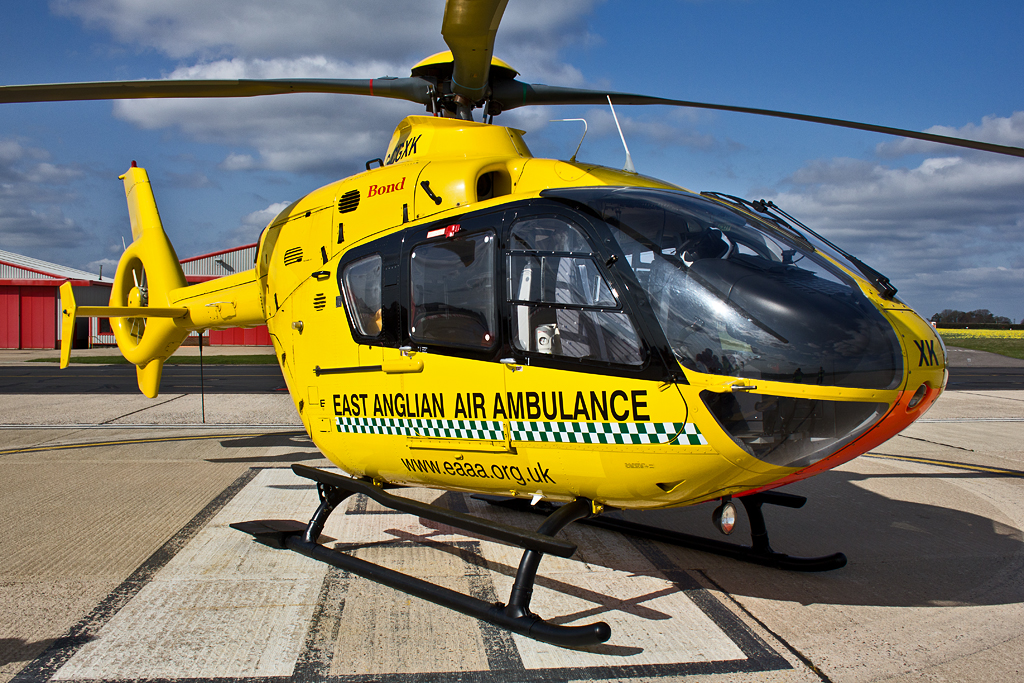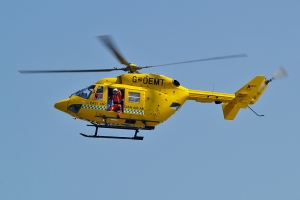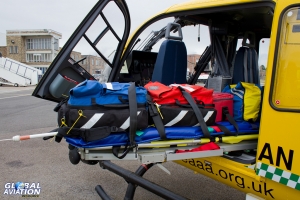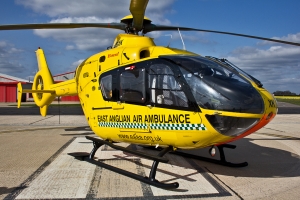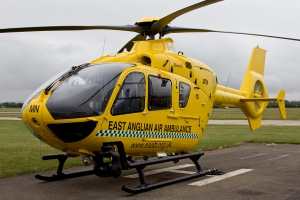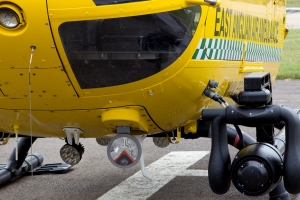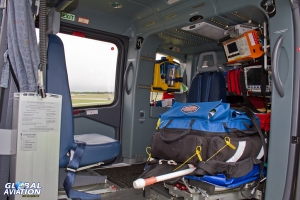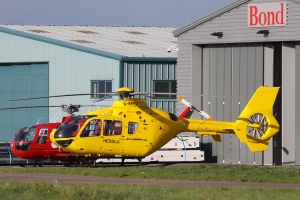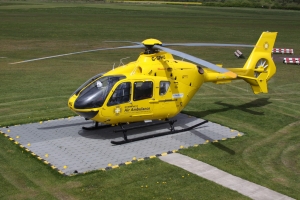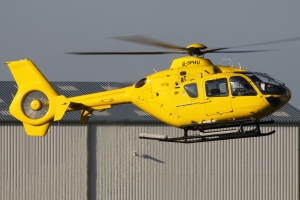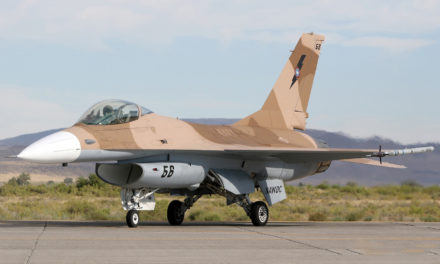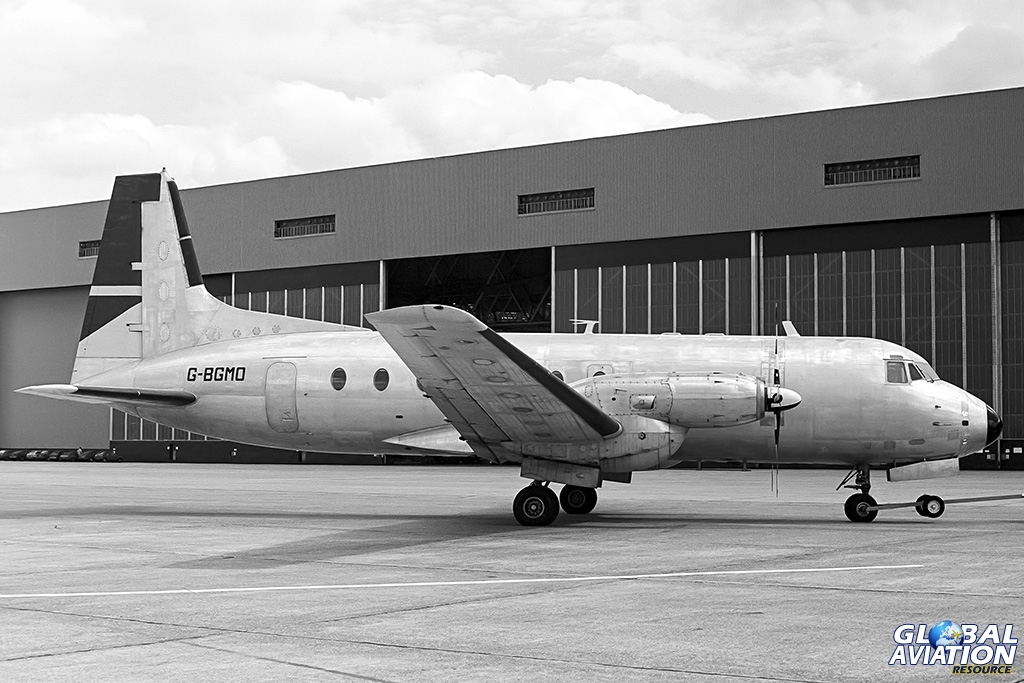The East Anglian Air Ambulance (EAAA) has recently been granted approval to carry out helicopter emergency medical service (HEMS) work at night, becoming the only air ambulance in the UK permitted to do so. Ryan Dorling guest reports for GAR from Cambridge Airport, the current home to one of EAAA’s present fleet of two helicopters.
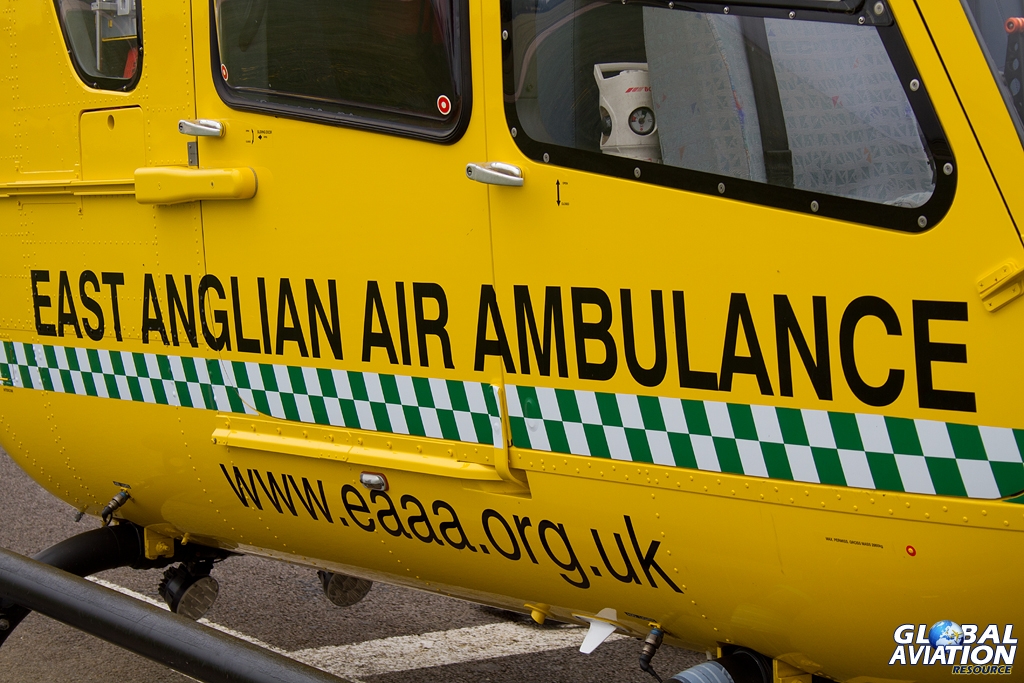
© Ryan Dorling
In 2000, an appeal was launched by professional jockey Frankie Dettori for the East Anglian region to have a dedicated medical helicopter, after he was involved in a light aircraft crash in June of that year whilst on his way to the Goodwood Festival of Speed. Since there was no medical helicopter serving the area at that time, another light aircraft had to fly the casualties into Addenbrooke’s Hospital!
The chairman of the East Anglian NHS Ambulance Trust, who at the time was Andrew Egerton-Smith, considered the advantages that a helicopter would give the region and agreed then to be the chairman of the trustees for the new charity.
Fundraising started in August, and by December the charity celebrated its first big achievement, having raised enough money to fly a one-day-a-week medical service with a Bolkow Bo 105 helicopter, which was contracted from Sterling Aviation and based at Norwich Airport. Using the callsign Anglia One, it would commence operations providing a service on a Friday only.
By March 2001, the fundraising had increased so much that the helicopter could operate on a five-day week, and by July the charity was operating on a seven-day week and was kept busy with an average of four missions a day.
The support kept growing for the EAAA, and, in November 2004, a dedicated helipad for Anglia One was constructed at the West Suffolk Hospital in Bury St Edmunds.
In June 2005 fundraising efforts had proven to be so successful that the EAAA could purchase a new MBB/Kawasaki BK 117 helicopter to replace the Bo 105. Again, the new aircraft was to be operated by Sterling Aviation and, in January 2006, it was delivered to Norwich Airport, where it underwent a medical refit, gaining stretchers, heart monitors and its new yellow livery. She came into service as G-OEMT, retaining the callsign of her predecessor, Anglia One.

© Ryan Dorling
A further appeal for fundraising was launched in April 2007 to enable the EAAA to extend its area of medical coverage to Bedfordshire and Cambridgeshire. This expansion would require the procurement of an additional helicopter which would be operated as Anglia Two. Incredibly, just four months later, the EAAA was operational in this new region. The BK 117 provided cover five days a week and was registered as G-RESC.

© Ryan Dorling
Following a further successful fundraising bid by the Lynn News, a helipad was made for the EAAA at the Queen Elizabeth II Hospital in King’s Lynn in December of the same year.
In August 2008, David Jason visited Anglia One at Norwich Airport and agreed to become the patron of the Air Ambulance Association. In October, Marshall Aerospace offered the EAAA a permanent base for Anglia Two at Cambridge, and by the end of 2008, the service was able to operate seven days a week.
A team of critical care paramedics was appointed to work solely on the helicopters in July 2009, and the EAAA celebrated its 10th anniversary the following year.
When 2011 arrived, the charity took a big step and changed operators from Sterling Aviation to Bond Air Services. Red Bolkow Bo 105s were used for a short time before the switch was made back to the familiar yellow colours with the delivery of the first Eurocopter EC135 helicopters.

The first of Bond’s Bo 105s, G-NAAA © Ryan Dorling
The following EC135s have been operated by Bond on behalf of EAAA:
- G-SPHU (HU) EC135 T2 (was only with the East Anglian Air Ambulance for a short amount of time and wasn’t fully marked in the EAAA’s markings; it just had the charity name written on the side)
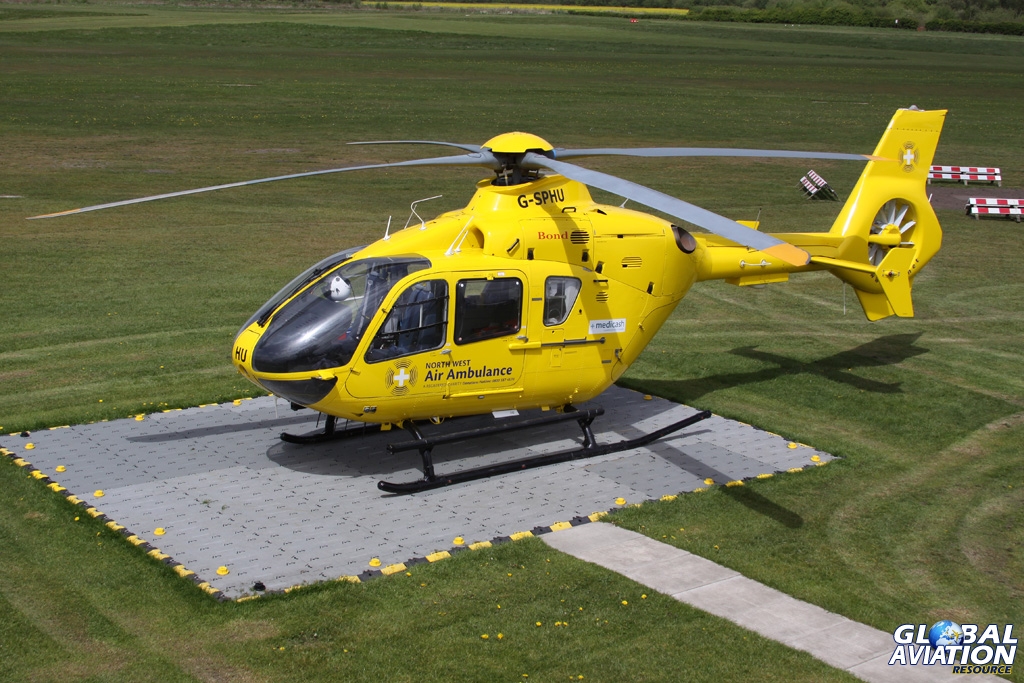
© John Higgins – www.globalaviationresource.com
- G-CGXK (XK) EC135 T1 (This EC135 was based at Norwich Airport in 2012 before moving to Cambridge. It has since been replaced by G-HEMN)

© Ryan Dorling
- G-CGZD (ZD) EC135 P2 (G-CGZD is now based at Norwich Airport where it took over from G-CGXK)
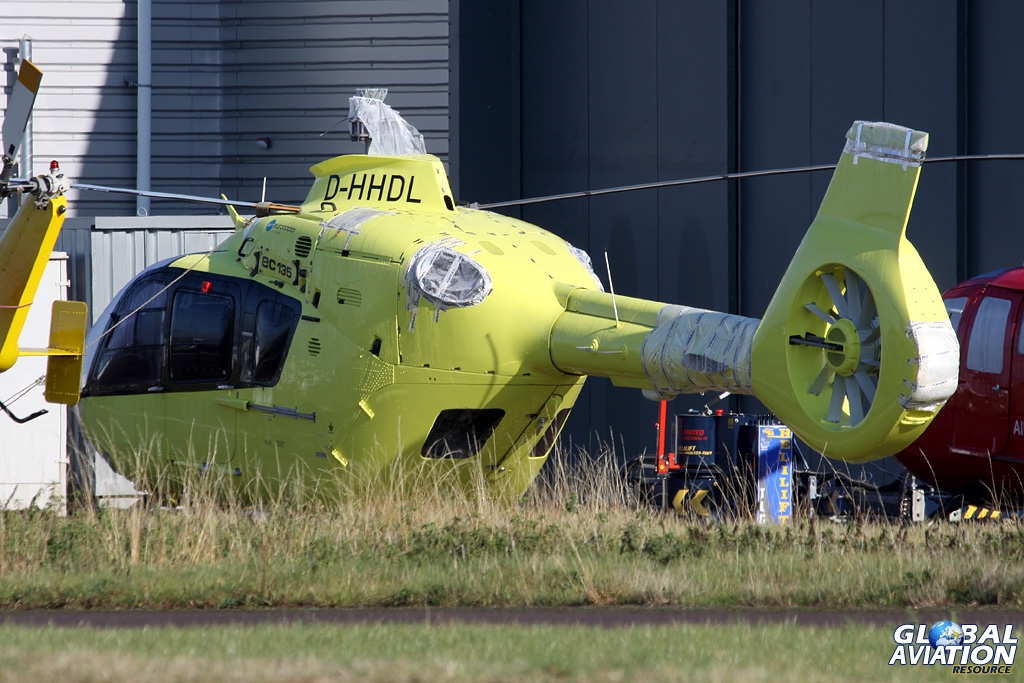
D-HHDL went on to become G-CGZD © John Higgins – www.globalaviationresource.com
- G-HEMN (MN) EC-135 T2e (Based at Cambridge)
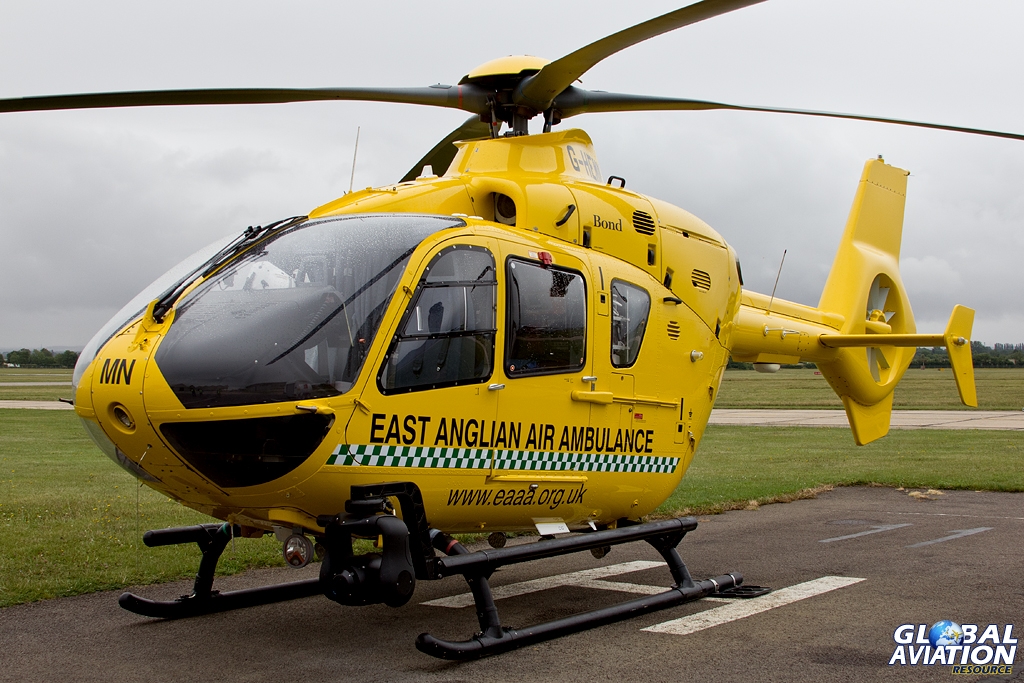
© Ryan Dorling
The EAAA’s current Helicopters
The East Anglian Air Ambulance’s current helicopters are two EC135s: G-CGZD (ZD), an EC135 P2, and G-HEMN (MN), an EC135 T2e. Both helicopters cover the Norfolk, Suffolk, Cambridgeshire and Bedfordshire area.

© Ryan Dorling
On 30 July 2013, I had the opportunity to travel to Marshall of Cambridge to speak to Captain Chris Sherriff and take a tour of G-HEMN, the newest arrival for the EAAA.
In May, the East Anglian Air Ambulance, after more than 18 months of hard work, became the only dedicated helicopter emergency medical service to be granted permission to operate at night in England and Wales.
I asked Captain Sherriff how the night capability has affected the EAAA:
“To put it into perspective, today there are five helicopters online within East Anglia all with a doctor and paramedic on-board, and at some point throughout the day we will be the only one available, so all of a sudden our area of coverage changes from a 10-15 minute flight from around the Cambridge Airport to suddenly the whole of East Anglia.

A comprehensive array of medical equipment is to be found in the cabin of G-HEMN © Ryan Dorling
“Despite the helicopter’s ability to fly at speeds of around 135 knots, to give you a rough idea, it will still take us about 35 minutes to get to some places on the north Norfolk Coast!”
With this helicopter being night capable, I was interested to find out what equipment the helicopter has been fitted out with to help the pilot to fulfil its expanded mission:
“We have a power line detection system, which is the big aerial at the front of the helicopter, which detects electrical current running through power lines. Also we have power line mapping, which shows us the 11kv cables and the big high-voltage metal lines. It won’t tell us where the cables are but it will warn us that there are cables in the vicinity, which helps us try and find a safe landing spot,” Captain Sherriff tells me.
“We also use the Tracker search light on the front of the helicopter to illuminate objects, and we also use NVGs (Night Vision Goggles) which clip on to a mount on our helmets, and all the dials are fitted with NVG filters, which is essential in a night capable aircraft of any kind.”
The Tracker search light fitted to G-HEMN © Ryan Dorling
It may be able to fly at night, but does the helicopter have any other limitations?
“Yes. The helicopter cannot fly in very low cloud or fog, and if the freezing level is low we’re prohibited from flying on instruments.”
Helicopter operations are notoriously expensive, but just what does it cost to keep the East Anglian Air Ambulance flying?
“That’s quite a difficult one to answer because with an air ambulance, it spends most of the time on the ground, but the fixed cost for it being there serviceable with a pilot will cost around about £2,000 a day, and then the charity would pay a subsequent cost to fly her.” Capt Sherriff continued, “If you wanted to hire one of these for commercial use it would cost you around about £2,500 per flying hour.”

G-HEMN’s stretcher © Ryan Dorling
While G-HEMN is night capable and newer, the helicopter at Norwich, G-CGZD, is not. I asked Captain Sherriff how the two compare:
“Well it’s a new helicopter so everything’s that much tighter. It’s just like a new car, things haven’t worn in properly yet.”
The East Anglian Air Ambulance is going to be taking delivery of a new EC145 helicopter in near future. The new model is slightly bigger than the current EC135P2 and T2e and will also be night capable. Once this new helicopter is received, G-HEMN will move from Cambridge Airport to Norwich Airport and G-CGZD will move on to another facility to either carry on its medical role or undertake another job.
Ryan Dorling would like to thank Helen Dodman for making the trip possible and Captain Chris Sherriff for taking time out of his schedule to talk about the helicopter.

